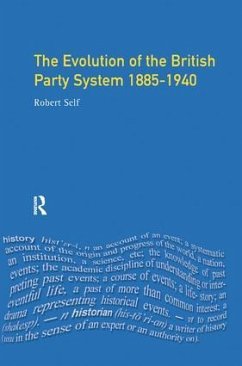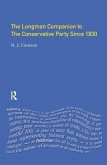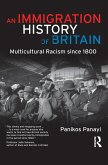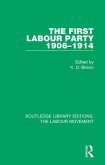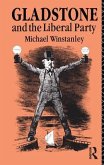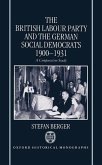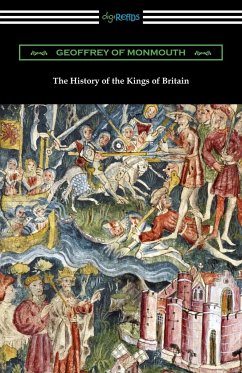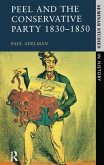- Gebundenes Buch
- Merkliste
- Auf die Merkliste
- Bewerten Bewerten
- Teilen
- Produkt teilen
- Produkterinnerung
- Produkterinnerung
By the end of the nineteenth century, reform and development of the British electoral system had inaugurated a new style of mass politics which fundamentally transformed the face of the British party system. This book traces the evolution of recognisably modern parties from their roots in the 1880s through half a century of dramatic change in organisational structure, electoral competition and constitutional thought.
Andere Kunden interessierten sich auch für
![The Longman Companion to the Conservative Party The Longman Companion to the Conservative Party]() Nick CrowsonThe Longman Companion to the Conservative Party197,99 €
Nick CrowsonThe Longman Companion to the Conservative Party197,99 €![An Immigration History of Britain An Immigration History of Britain]() Panikos PanayiAn Immigration History of Britain197,99 €
Panikos PanayiAn Immigration History of Britain197,99 €![The First Labour Party 1906-1914 The First Labour Party 1906-1914]() The First Labour Party 1906-1914153,99 €
The First Labour Party 1906-1914153,99 €![Gladstone and the Liberal Party Gladstone and the Liberal Party]() Michael J WinstanleyGladstone and the Liberal Party197,99 €
Michael J WinstanleyGladstone and the Liberal Party197,99 €![The British Labour Party and the German Social Democrats, 1900-1931 The British Labour Party and the German Social Democrats, 1900-1931]() Stefan BergerThe British Labour Party and the German Social Democrats, 1900-193184,99 €
Stefan BergerThe British Labour Party and the German Social Democrats, 1900-193184,99 €![The History of the Kings of Britain The History of the Kings of Britain]() Geoffrey Of MonmouthThe History of the Kings of Britain17,99 €
Geoffrey Of MonmouthThe History of the Kings of Britain17,99 €![Peel and the Conservative Party 1830-1850 Peel and the Conservative Party 1830-1850]() Paul AdelmanPeel and the Conservative Party 1830-1850197,99 €
Paul AdelmanPeel and the Conservative Party 1830-1850197,99 €-
-
-
By the end of the nineteenth century, reform and development of the British electoral system had inaugurated a new style of mass politics which fundamentally transformed the face of the British party system. This book traces the evolution of recognisably modern parties from their roots in the 1880s through half a century of dramatic change in organisational structure, electoral competition and constitutional thought.
Hinweis: Dieser Artikel kann nur an eine deutsche Lieferadresse ausgeliefert werden.
Hinweis: Dieser Artikel kann nur an eine deutsche Lieferadresse ausgeliefert werden.
Produktdetails
- Produktdetails
- Verlag: Taylor & Francis Ltd (Sales)
- Seitenzahl: 230
- Erscheinungstermin: 7. Februar 2017
- Englisch
- Abmessung: 234mm x 156mm x 14mm
- Gewicht: 503g
- ISBN-13: 9781138166325
- ISBN-10: 1138166324
- Artikelnr.: 69948030
- Herstellerkennzeichnung
- Libri GmbH
- Europaallee 1
- 36244 Bad Hersfeld
- gpsr@libri.de
- Verlag: Taylor & Francis Ltd (Sales)
- Seitenzahl: 230
- Erscheinungstermin: 7. Februar 2017
- Englisch
- Abmessung: 234mm x 156mm x 14mm
- Gewicht: 503g
- ISBN-13: 9781138166325
- ISBN-10: 1138166324
- Artikelnr.: 69948030
- Herstellerkennzeichnung
- Libri GmbH
- Europaallee 1
- 36244 Bad Hersfeld
- gpsr@libri.de
Robert C. Self is Senior Lecturer in Politics at London Guildhall University.
Acknowledgements XI
1 Introduction 1
Notes and references 4
2 Development of the electoral system before 1914 6
2.1 The Franchise and Redistribution Acts, 1884-1885 6
2.2 The elimination of corruption and intimidation 10
2.3 The franchise in Britain after 1885: 'Democracy
tempered by registration' 13
Notes and references 18
3 The rise of modern party organisation 21
3.1 Extra-parliamentary organisation 22
3.2 Linking the grassroots to the leaders: the National Union
and the Liberal caucus 28
3.3 The emergence of a central party bureaucracy 31
3.4 Discipline and control in the parliamentary parties 34
3.5 The rise of national campaigning, manifestos and
programmatic politics 36
Notes and references 38
4 Party realignment and Unionist ascendancy, 1885-1905 41
4.1 Gladstonian Liberalism and the schism of 1886 41
4.2 Liberal malaise, 1886-1902 44
4.3 Liberals, Labour and the birth of the Progressive Alliance 50
4.4 Lord Salisbury and the Unionist alliance 55
4.5 Unionist decline and Liberal revival, 1900-1906 61
Notes and references 64
5 The challenge of New Liberalism, 1906-1914 69
5.1 The reformulation of Liberalism 69
5.2 The conversion of the Liberal party 71
5.3 Liberals and the politics of taxation 74
5.4 Unionist crisis and the politics of taxation, 1906-1910 77
viii Contents
5.5 Labour, the Progressive Alliance and the New Liberalism 80
5.6 Rumours of a 'Strange Death', 1910-1914 84
5.7 The electorate and the New Liberalism 88
5.8 Conclusion: the significance of the New Liberalism 92
Notes and references 94
6 War and the party system 99
6.1 Liberalism divided 99
6.2 Liberal ideology and the strains of war 105
6.3 Conservatism and the challenge of war 109
6.4 Collapse of the Progressive Alliance and Labour's bid for
independence 112
6.5 Labour, 'socialism' and the impact of war 115
6.6 The 'coupon' election of December 1918 118
Notes and references 120
7 The Lloyd George Coalition, 1918-1922 124
7.1 The impact of Labour 124
7 .2 Coalition, reconstruction and resistance to socialism 127
7.3 Slump and the destruction of 'national unity' 129
7.4 Anti-socialist 'fusion' and the realignment of the
centre-right 132
7.5 The fall of the Coalition 133
Notes and references 138
8 Three-party confusion in the 1920s 140
8.1 Explanations for party realignment 140
8.2 The 'franchise factor' and the Fourth Reform Act of 1918 142
8.3 The organisational factor in Labour rise and Liberal decline 146
8.4 Labour, Liberals and the battle of ideas 149
8.5 The impact of the first Labour government 156
8.6 The foundations of Conservative electoral hegemony 159
8. 7 The 1929 election: the end of the three-party era 168
Notes and references 171
9 The National Governments 176
9.1 The party crisis, 1929-1931 176
9 .2 The political crisis and the National Government 179
9.3 The character of the National Government 183
9 .4 The collapse of independent Liberalism 188
9.5 Labour responses to 1931: leadership, power and organisation 189
9.6 Labour's ideological response to 1931 191
9.7 Party politics and the 'impact of Hitler' 195
9.8 The failure of political extremism in the 1930s 197
9. 9 Electoral competition and the onset of war 199
Notes and references 202
Select Bibliography
General background histories
The electoral system
Party development and management
Elections and electoral behaviour
Party histories: the Conservatives
The Labour party
The Liberal party
Extremist parties
Coalition and 'National Government'
Party doctrine and thought
Index
1 Introduction 1
Notes and references 4
2 Development of the electoral system before 1914 6
2.1 The Franchise and Redistribution Acts, 1884-1885 6
2.2 The elimination of corruption and intimidation 10
2.3 The franchise in Britain after 1885: 'Democracy
tempered by registration' 13
Notes and references 18
3 The rise of modern party organisation 21
3.1 Extra-parliamentary organisation 22
3.2 Linking the grassroots to the leaders: the National Union
and the Liberal caucus 28
3.3 The emergence of a central party bureaucracy 31
3.4 Discipline and control in the parliamentary parties 34
3.5 The rise of national campaigning, manifestos and
programmatic politics 36
Notes and references 38
4 Party realignment and Unionist ascendancy, 1885-1905 41
4.1 Gladstonian Liberalism and the schism of 1886 41
4.2 Liberal malaise, 1886-1902 44
4.3 Liberals, Labour and the birth of the Progressive Alliance 50
4.4 Lord Salisbury and the Unionist alliance 55
4.5 Unionist decline and Liberal revival, 1900-1906 61
Notes and references 64
5 The challenge of New Liberalism, 1906-1914 69
5.1 The reformulation of Liberalism 69
5.2 The conversion of the Liberal party 71
5.3 Liberals and the politics of taxation 74
5.4 Unionist crisis and the politics of taxation, 1906-1910 77
viii Contents
5.5 Labour, the Progressive Alliance and the New Liberalism 80
5.6 Rumours of a 'Strange Death', 1910-1914 84
5.7 The electorate and the New Liberalism 88
5.8 Conclusion: the significance of the New Liberalism 92
Notes and references 94
6 War and the party system 99
6.1 Liberalism divided 99
6.2 Liberal ideology and the strains of war 105
6.3 Conservatism and the challenge of war 109
6.4 Collapse of the Progressive Alliance and Labour's bid for
independence 112
6.5 Labour, 'socialism' and the impact of war 115
6.6 The 'coupon' election of December 1918 118
Notes and references 120
7 The Lloyd George Coalition, 1918-1922 124
7.1 The impact of Labour 124
7 .2 Coalition, reconstruction and resistance to socialism 127
7.3 Slump and the destruction of 'national unity' 129
7.4 Anti-socialist 'fusion' and the realignment of the
centre-right 132
7.5 The fall of the Coalition 133
Notes and references 138
8 Three-party confusion in the 1920s 140
8.1 Explanations for party realignment 140
8.2 The 'franchise factor' and the Fourth Reform Act of 1918 142
8.3 The organisational factor in Labour rise and Liberal decline 146
8.4 Labour, Liberals and the battle of ideas 149
8.5 The impact of the first Labour government 156
8.6 The foundations of Conservative electoral hegemony 159
8. 7 The 1929 election: the end of the three-party era 168
Notes and references 171
9 The National Governments 176
9.1 The party crisis, 1929-1931 176
9 .2 The political crisis and the National Government 179
9.3 The character of the National Government 183
9 .4 The collapse of independent Liberalism 188
9.5 Labour responses to 1931: leadership, power and organisation 189
9.6 Labour's ideological response to 1931 191
9.7 Party politics and the 'impact of Hitler' 195
9.8 The failure of political extremism in the 1930s 197
9. 9 Electoral competition and the onset of war 199
Notes and references 202
Select Bibliography
General background histories
The electoral system
Party development and management
Elections and electoral behaviour
Party histories: the Conservatives
The Labour party
The Liberal party
Extremist parties
Coalition and 'National Government'
Party doctrine and thought
Index
Acknowledgements XI
1 Introduction 1
Notes and references 4
2 Development of the electoral system before 1914 6
2.1 The Franchise and Redistribution Acts, 1884-1885 6
2.2 The elimination of corruption and intimidation 10
2.3 The franchise in Britain after 1885: 'Democracy
tempered by registration' 13
Notes and references 18
3 The rise of modern party organisation 21
3.1 Extra-parliamentary organisation 22
3.2 Linking the grassroots to the leaders: the National Union
and the Liberal caucus 28
3.3 The emergence of a central party bureaucracy 31
3.4 Discipline and control in the parliamentary parties 34
3.5 The rise of national campaigning, manifestos and
programmatic politics 36
Notes and references 38
4 Party realignment and Unionist ascendancy, 1885-1905 41
4.1 Gladstonian Liberalism and the schism of 1886 41
4.2 Liberal malaise, 1886-1902 44
4.3 Liberals, Labour and the birth of the Progressive Alliance 50
4.4 Lord Salisbury and the Unionist alliance 55
4.5 Unionist decline and Liberal revival, 1900-1906 61
Notes and references 64
5 The challenge of New Liberalism, 1906-1914 69
5.1 The reformulation of Liberalism 69
5.2 The conversion of the Liberal party 71
5.3 Liberals and the politics of taxation 74
5.4 Unionist crisis and the politics of taxation, 1906-1910 77
viii Contents
5.5 Labour, the Progressive Alliance and the New Liberalism 80
5.6 Rumours of a 'Strange Death', 1910-1914 84
5.7 The electorate and the New Liberalism 88
5.8 Conclusion: the significance of the New Liberalism 92
Notes and references 94
6 War and the party system 99
6.1 Liberalism divided 99
6.2 Liberal ideology and the strains of war 105
6.3 Conservatism and the challenge of war 109
6.4 Collapse of the Progressive Alliance and Labour's bid for
independence 112
6.5 Labour, 'socialism' and the impact of war 115
6.6 The 'coupon' election of December 1918 118
Notes and references 120
7 The Lloyd George Coalition, 1918-1922 124
7.1 The impact of Labour 124
7 .2 Coalition, reconstruction and resistance to socialism 127
7.3 Slump and the destruction of 'national unity' 129
7.4 Anti-socialist 'fusion' and the realignment of the
centre-right 132
7.5 The fall of the Coalition 133
Notes and references 138
8 Three-party confusion in the 1920s 140
8.1 Explanations for party realignment 140
8.2 The 'franchise factor' and the Fourth Reform Act of 1918 142
8.3 The organisational factor in Labour rise and Liberal decline 146
8.4 Labour, Liberals and the battle of ideas 149
8.5 The impact of the first Labour government 156
8.6 The foundations of Conservative electoral hegemony 159
8. 7 The 1929 election: the end of the three-party era 168
Notes and references 171
9 The National Governments 176
9.1 The party crisis, 1929-1931 176
9 .2 The political crisis and the National Government 179
9.3 The character of the National Government 183
9 .4 The collapse of independent Liberalism 188
9.5 Labour responses to 1931: leadership, power and organisation 189
9.6 Labour's ideological response to 1931 191
9.7 Party politics and the 'impact of Hitler' 195
9.8 The failure of political extremism in the 1930s 197
9. 9 Electoral competition and the onset of war 199
Notes and references 202
Select Bibliography
General background histories
The electoral system
Party development and management
Elections and electoral behaviour
Party histories: the Conservatives
The Labour party
The Liberal party
Extremist parties
Coalition and 'National Government'
Party doctrine and thought
Index
1 Introduction 1
Notes and references 4
2 Development of the electoral system before 1914 6
2.1 The Franchise and Redistribution Acts, 1884-1885 6
2.2 The elimination of corruption and intimidation 10
2.3 The franchise in Britain after 1885: 'Democracy
tempered by registration' 13
Notes and references 18
3 The rise of modern party organisation 21
3.1 Extra-parliamentary organisation 22
3.2 Linking the grassroots to the leaders: the National Union
and the Liberal caucus 28
3.3 The emergence of a central party bureaucracy 31
3.4 Discipline and control in the parliamentary parties 34
3.5 The rise of national campaigning, manifestos and
programmatic politics 36
Notes and references 38
4 Party realignment and Unionist ascendancy, 1885-1905 41
4.1 Gladstonian Liberalism and the schism of 1886 41
4.2 Liberal malaise, 1886-1902 44
4.3 Liberals, Labour and the birth of the Progressive Alliance 50
4.4 Lord Salisbury and the Unionist alliance 55
4.5 Unionist decline and Liberal revival, 1900-1906 61
Notes and references 64
5 The challenge of New Liberalism, 1906-1914 69
5.1 The reformulation of Liberalism 69
5.2 The conversion of the Liberal party 71
5.3 Liberals and the politics of taxation 74
5.4 Unionist crisis and the politics of taxation, 1906-1910 77
viii Contents
5.5 Labour, the Progressive Alliance and the New Liberalism 80
5.6 Rumours of a 'Strange Death', 1910-1914 84
5.7 The electorate and the New Liberalism 88
5.8 Conclusion: the significance of the New Liberalism 92
Notes and references 94
6 War and the party system 99
6.1 Liberalism divided 99
6.2 Liberal ideology and the strains of war 105
6.3 Conservatism and the challenge of war 109
6.4 Collapse of the Progressive Alliance and Labour's bid for
independence 112
6.5 Labour, 'socialism' and the impact of war 115
6.6 The 'coupon' election of December 1918 118
Notes and references 120
7 The Lloyd George Coalition, 1918-1922 124
7.1 The impact of Labour 124
7 .2 Coalition, reconstruction and resistance to socialism 127
7.3 Slump and the destruction of 'national unity' 129
7.4 Anti-socialist 'fusion' and the realignment of the
centre-right 132
7.5 The fall of the Coalition 133
Notes and references 138
8 Three-party confusion in the 1920s 140
8.1 Explanations for party realignment 140
8.2 The 'franchise factor' and the Fourth Reform Act of 1918 142
8.3 The organisational factor in Labour rise and Liberal decline 146
8.4 Labour, Liberals and the battle of ideas 149
8.5 The impact of the first Labour government 156
8.6 The foundations of Conservative electoral hegemony 159
8. 7 The 1929 election: the end of the three-party era 168
Notes and references 171
9 The National Governments 176
9.1 The party crisis, 1929-1931 176
9 .2 The political crisis and the National Government 179
9.3 The character of the National Government 183
9 .4 The collapse of independent Liberalism 188
9.5 Labour responses to 1931: leadership, power and organisation 189
9.6 Labour's ideological response to 1931 191
9.7 Party politics and the 'impact of Hitler' 195
9.8 The failure of political extremism in the 1930s 197
9. 9 Electoral competition and the onset of war 199
Notes and references 202
Select Bibliography
General background histories
The electoral system
Party development and management
Elections and electoral behaviour
Party histories: the Conservatives
The Labour party
The Liberal party
Extremist parties
Coalition and 'National Government'
Party doctrine and thought
Index

